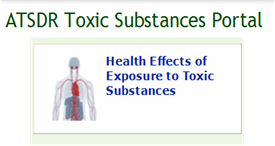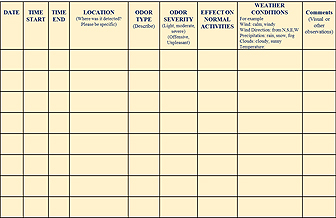Frequently Asked Questions (FAQ)
What are environmental odors?
Many substances in the environment can produce odors. You typically smell these odors when you are outdoors and sometimes when you are indoors with your windows open. You may smell and react to certain chemicals in the air before they are at harmful levels. Those odors can become a nuisance and bother people, causing temporary symptoms such as headache and nausea. Other odors can be toxic and cause harmful health effects.
Where do environmental odors come from?
Environmental odors can come from many sources:

- Animals: Confined animal feeding operations (CAFOs)
- Human activities: Compost, sewage, garbage, fires, household cleaning agents
- Industry: Oil refineries, landfills, paper mills, wastewater treatment plants
- Nature: Moist soil, gardens, fires
- Vehicles: Diesel exhaust
Can environmental odors make me sick?
Everyone reacts to odors differently. Some people are more sensitive to environmental odors than others. When you are more sensitive to an odor, you may have symptoms even at a low concentration of the odor in air. In general, as concentration levels increase, more people will have symptoms.
What symptoms can I expect?
Symptoms vary based on your sensitivity to the odor. In most cases, symptoms will depend on the type of substance, its concentration in air, how often exposure occurs (frequency), how long exposure lasts (duration), your age, and your state of health.
Young children, the elderly, and pregnant women may be more sensitive to odors. In general, the most common symptoms are

- Headaches
- Nasal congestion
- Eye, nose, and throat irritation
- Hoarseness, sore throat
- Cough
- Chest tightness
- Shortness of breath
- Wheezing
- Heart Palpitations
- Nausea
- Drowsiness
- Mental depression
These symptoms generally occur at the time of exposure. Their intensity will depend on the concentration of the odor in air, how often you smell it, and how long exposure lasts.
- If the concentration of an odor in air is below levels of irritation (levels known to cause eye, nose, or throat irritation in people), the symptoms will pass when you move out of the exposure area.
- If the concentration of an odor in air is at or above levels of irritation and the exposure duration is longer, the symptoms may last after moving out of the exposure area.
Are all environmental odors toxic?
No. Toxicity is the degree to which a substance (a toxin) can harm humans or animals. The following factors affect toxicity.
New Are Environmental Odors Toxic Factsheet [PDF - 2MB]

- Toxicity depends on the amount of a substance (concentration) in the air you breathe, how often (frequency) you breathe that air, and how much time (duration) you spend breathing that air.
- If a substance level in air is high, happens often, and last a long time, the odor can become toxic and cause adverse health effects.
- If those conditions do not exist, odors are generally not toxic.
- If you are sensitive to environmental odors, you may react to low concentrations of a substance in air. The length of exposure is important whether you are sensitive or not.
For more information on toxic substances, visit ATSDR’s Toxic Substances Portal.
How do I know what substance I am smelling?
Visit the “What is that odor?” section of this website. There you can describe an odor and find the substance(s) that produce that odor. You can also look up a specific substance and find a description of its odor.
To find chemicals released in your area, you can search EPA’s Toxic Release Inventory (TRI).
Are environmental odors regulated in the United States?
In general, no. The U.S. Environmental Protection Agency (EPA) regulates pollutants in outdoor air through the National Ambient Air Quality Standards (NAAQS). The NAAQS regulates

- Carbon monoxide (CO)
- Lead (Pb)
- Nitrogen dioxide (NO2)
- Ozone (O3)
- Particulate Matter (PM) and
- Sulfur dioxide (SO2).
Sulfur dioxide is the only regulated air pollutant with a strong, pungent odor.
Under the Clean Air Act, EPA must control 187 hazardous air pollutants, also known as toxic air pollutants or air toxics. EPA controls those chemicals for their toxicity, not for their odor. EPA requires them to be controlled at the source that generates the emissions. See the EPA website for more information: http://www.epa.gov/ttn/atw/pollsour.html
Although environmental odors are not nationally regulated in the United States, many cities and local governments have established nuisance odor regulations. You can find more information by contacting your city or county health department or your state environmental department.
Can I petition ATSDR to ask for an evaluation of environmental odors in my neighborhood?

ATSDR develops public health consultations about hazardous waste sites or facilities. You can petition ATSDR to evaluate environmental health exposures in your community. However, ATSDR needs available environmental sampling data to conduct an evaluation. These data are typically gathered by the EPA or a state environmental regulatory agency.
Learn more about
What can ATSDR do to help with environmental odors in my neighborhood?
If ATSDR is working in your neighborhood to assess environmental exposures, the agency can help by doing one or more of the following:
- Working with the facility producing the odors or local regulators to
- Recommend changes in times of operation, for example suspending or reducing the odor-producing operations during the time(s) of the day or week when the odors are worse (as noted in the odor diaries).
- Recommend ways to reduce emissions. Examples include planting trees, modifying engineering techniques, increasing stack height, or changing filters more frequently.
- Providing environmental health education to primary care providers in the area
- Recommending personal actions to reduce exposure such as
- Staying indoors when environmental odors are strong
- Exercising indoors on bad odor days
- Leaving the area for a few hours

What can my community do about environmental odors?
- You can keep personal odor diaries to track the odors in the community.
- You can organize to assess the effect environmental odors have on your community.
- You can appeal to local government for policy changes.
- You can appeal to industry to make operational changes to reduce odors.
Odor diaries can help distinguish odor types and times of the day or night when odors are worse. See our Air Pollution Odor Diary webpage for more information about odor diaries.

I have asthma. Can environmental odors make my asthma worse?
In many cases, yes, odors can make asthma worse. Using your inhaler, staying indoors, or leaving the area for a few hours can help.
I have chronic obstructive pulmonary disease (COPD) or emphysema. Can environmental odors make my COPD or emphysema worse?
In many cases, yes, odors can make COPD or emphysema worse. Using your inhalers, staying indoors, or leaving the area for a few hours can help.

I am pregnant. Can environmental odors affect the baby I am carrying?
In general, the effect on an unborn baby depends on the amount of substance (concentration) in the air that you are breathing, how often (frequency) you are breathing that air, how much time (duration) you spend breathing that air, and the stage in your pregnancy (the baby is more vulnerable during the first trimester).
Staying indoors during bad odor days or leaving the area for a few hours can help.
Are children more sensitive to the effects of environmental odors?
They may be. Young children have a faster breathing rate than adults, so they breathe in more of the odors.
Some chemicals producing the environmental odors can be heavier than air and stay closer to the ground where children play. Because children are small and play or crawl on the ground, they can have higher exposure to these odors-producing chemicals.

Are elderly people more sensitive to the effects of environmental odors?
They may be. The sense of smell decreases with age. Sometimes elderly people may not be able to smell environmental odors, so they continue to stay in an affected area. Symptoms will depend on their health status, amount of substance (concentration) in the air that they are breathing, how often (frequency) they are breathing that air, and how much time (duration) they spend breathing that air.

I walk/jog for exercise in my neighborhood. Am I at risk for developing environmental odor symptoms?
In general, developing odor symptoms depends on the amount of a substance (concentration) in the air that you are breathing, how often (frequency) you are breathing that air, and how much time (duration) you spend breathing that air. However, if you are sensitive to environmental odors, any level of odor may make you feel sick. Jogging and other forms of exercise increase your breathing rate, making you breathe in more of the odor. During bad odor days, exercising indoors or in another location can help.
- Page last reviewed: October 23, 2015
- Page last updated: February 10, 2017
- Content source:



 ShareCompartir
ShareCompartir